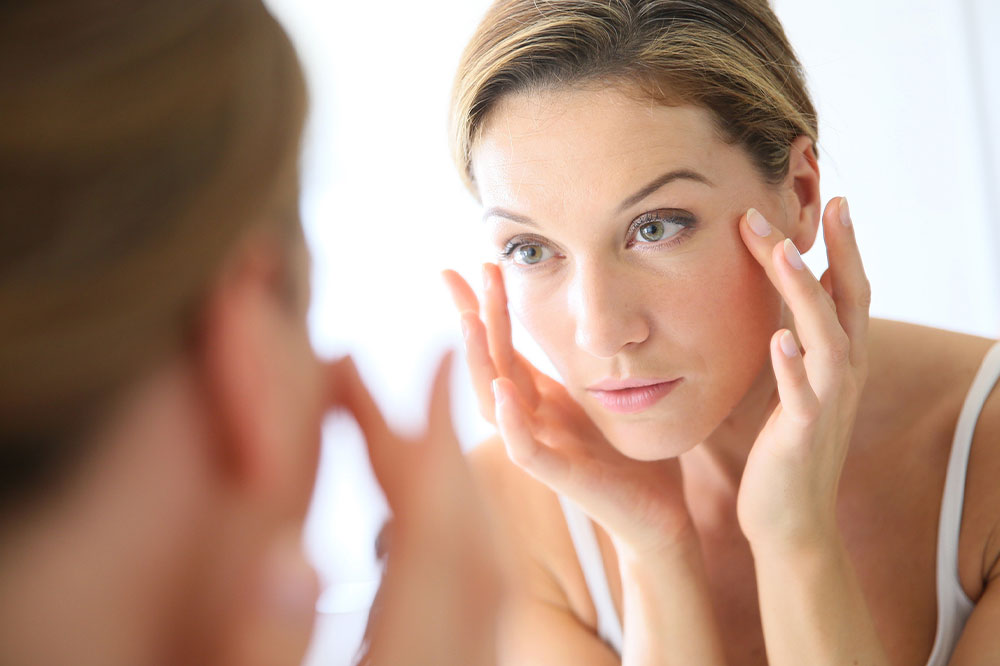Natural remedies and foods to manage wrinkles

Wrinkles, also known as rhytid, are fine lines or creases appearing on a person’s skin as they age. They are a normal part of the aging process and are found mostly on your face, neck, legs, and arms. While some people embrace this sign of aging, some actively look for ways to reduce wrinkles. So, if you are looking for ways to get rid of wrinkles, here are some helpful natural remedies.
Causes
Before discussing the natural remedies to reduce and prevent wrinkles, people must understand the reasons that increase their chances of getting wrinkles. One of the main reasons is that your skin produces fewer natural oils and collagen as you age. Along with this, the fat in the layers of your skin also dries up. It leads to the appearance of wrinkles . Besides this, other environmental factors may speed up the process of aging. These include long-term exposure to UV radiation, unhealthy lifestyle habits, lack of proper skincare routine, and repetitive facial movements and muscle contractions.
Natural remedies to prevent and control wrinkles
Today, several treatments are available to control and manage wrinkles . These range from topical creams to more invasive options such as surgery. However, these treatments may involve several side effects, such as allergic reactions, facial pain, swelling, bruising, and redness.
Add to this the fact that anti-aging treatments are expensive and cannot fit into everyone’s budget. It is one of the reasons why more people worldwide are opting for natural remedies to manage wrinkles . Some of the most-effective remedies for the reduction of wrinkles are listed here .
Applying skin-firming oils
Certain oils act as collagen boosters for your skin and delay the onset of wrinkles. According to experts, coriander essential oil is a powerful remedy for wrinkles. It enhances collagen production and reduces the harmful impact of UV radiation that induces premature wrinkles .
Observing your facial expressions
There are several repetitive movements that a person indulges in every day. These include frowning, smiling, laughing, squinting, and more. While these are natural expressions, these facial movements can contribute to wrinkles . When you make these movements often, the collagen in that area starts to break. It causes the skin to lose elasticity, leading to fine lines forming. To counter this, you don’t need to stop smiling or laughing. Instead, only be mindful of expressions such as frowning or squinting that you can control.
Reducing exposure to the sun
Sun damage is one of the most common reasons for wrinkles. When you expose unprotected skin to the UV rays in the sun, they cause photodamage. It happens because these harsh rays break down the collagen and elastin in the skin. That’s not all, as these rays also cause pigmentation, sagging, and skin cancer in severe cases. The best way to safeguard your skin from sun damage is by wearing protective clothing and applying sunscreen before going outdoors. Remember to re-apply it after every two hours. Also, avoid stepping out in the sun between 10 am to 4 pm because it is when the sun is at its sharpest and causes the most damage.
Applying lemon juice
Abundant in vitamin C, lemon juice is a natural astringent. It also contains antioxidants that help firm up your skin and reduce premature signs of aging, such as wrinkles. It also helps in boosting the production of collagen and delays wrinkles. There are several ways to include this excellent ingredient in your routine. You can start your day by drinking a glass of warm water with lemon. To apply it on the face, combine the fresh juice of lemon with equal amounts of water and apply it twice or thrice every day.
Using egg whites
Eggs are great for your health and make your skin appear youthful and beautiful. Egg whites, especially, are abundant in collagen. When used over a certain period, they help in improving your skin’s elasticity and tighten it. To prepare an egg white mask, combine one egg white with the juice of half a lemon. Whisk this mixture and apply it on your face and neck. Leave it for ten-fifteen minutes on your face and wash it with warm water.
Trying facial exercises
As you age, the muscles in your body lose their strength. It is also true for the fifty-seven muscles in your face. Couple this with the fact that you lose collagen and elastin with aging. All this contributes to wrinkles and sagging in the facial and neck area. To prevent this, you must include gentle facial exercises in your routine. Exercising improves blood circulation and supplies the skin with oxygen and nutrients essential to maintaining flexibility. Some of the best exercises include the Jaw Flex, Cheekbone Lift, and Cheek Squeeze.
Making changes to the nutritional regime
Unbeknownst to many, one can make simple changes to one’s food routine and achieve younger-looking skin. There are some ‘skin superfoods’ that are known to improve the health of the skin. Some of these include the following-
- Red bell pepper is rich in vitamin C and antioxidants.
- Papayas are abundant in vitamins A, C, E, and K, along with calcium, potassium, and phosphorus.
- Broccoli is a known anti-aging vegetable rich in antioxidants, fiber, and folate.
- Nuts such as almonds and walnuts are good sources of vitamin E, which protect your skin from sun damage and moisturizes it.
- Blueberries, kale, spinach, and grapes are rich in antioxidants and help reduce the signs of premature aging.
Skin with fine lines is a sign of life enjoyed and well-lived. However, one can consider including these tips in the routine if one is overly concerned about wrinkles and want to remove them. Before making any significant changes to your routine, consult a dermatologist or healthcare professional for the best results. Skincare practices like the ones mentioned above, when followed on a daily basis, will help maintain healthy and youthful skin to a great extent.

